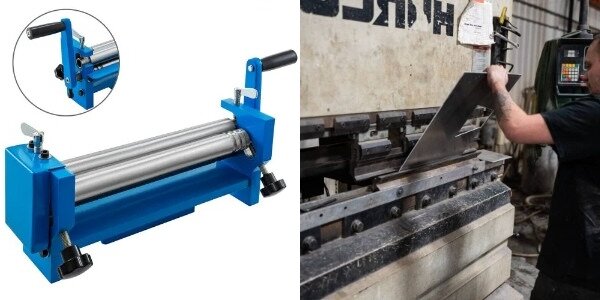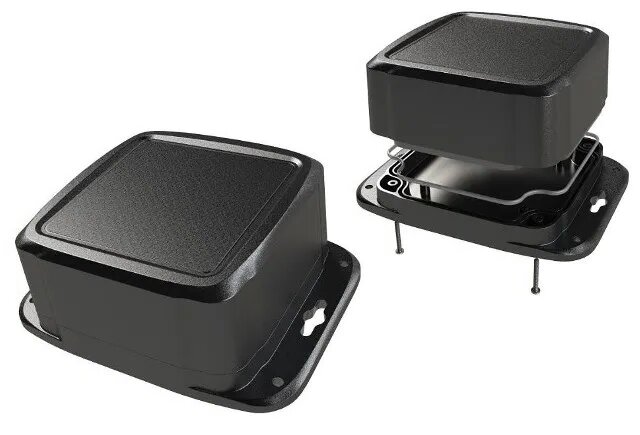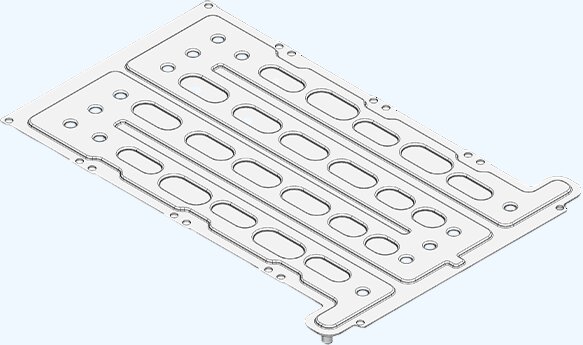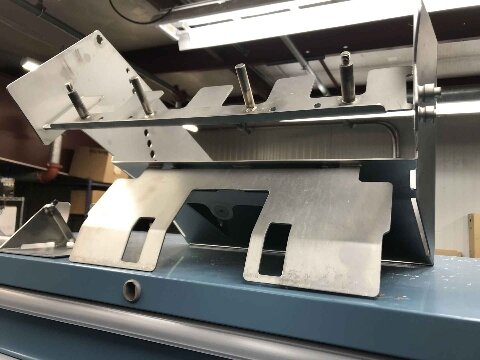나사산 설계는 간단해 보일 수 있지만, 나사산을 제대로 계획하지 않아서 실패하는 CNC 부품이 많습니다. 잘못 설계된 나사산은 벗겨지거나 정렬이 잘못되거나 조립을 어렵게 만들 수 있습니다. 이로 인해 시간이 낭비되고 비용이 증가합니다. 엔지니어와 설계자는 특정 재료나 응용 분야에 가장 적합한 나사 유형, 피치 또는 깊이가 무엇인지 궁금해하는 경우가 많습니다.
이 가이드는 튼튼하고 정확하며 가공하기 쉬운 나사산을 설계하는 방법을 보여줍니다. 올바른 나사산 유형을 선택하고, 적절한 결합을 보장하며, 생산 속도를 늦추거나 부품을 손상시킬 수 있는 실수를 방지하는 방법을 배웁니다. 이 단계를 따르면 신뢰할 수 있는 CNC 부품을 보다 효율적으로 제작할 수 있습니다.
좋은 스레드 디자인은 조립된 모든 구성 요소의 기초를 형성합니다. 잘 작동하고 가공하기 쉬운 스레드를 만들 수 있도록 핵심 아이디어를 세분화하여 설명합니다.
스레드 지오메트리의 기초
스레드를 디자인하기 전에 스레드의 기하학적 구조를 이해하는 것이 도움이 됩니다. 스레드는 단순한 나선형 홈 그 이상입니다. 스레드에는 모양, 강도 및 착용감을 결정하는 특정 기능이 있습니다.
스레드의 핵심 요소
3D 스레드는 단순해 보이지만 정확하게 함께 작동해야 하는 여러 기하학적 특징에 의해 정의됩니다:
- 기본 지름: 이것은 스레드 크레스트 전체에서 측정한 가장 큰 직경입니다. 예를 들어 1/4"-20 UNC 스레드의 기본 직경은 6.35mm(0.25인치)입니다.
- 마이너 지름: 이것은 나사산 뿌리를 가로질러 측정한 가장 작은 지름입니다. 1/4"-20 UNC 스레드의 경우 약 5.16mm(0.203인치)입니다. 작은 직경에 따라 패스너의 코어 강도가 결정됩니다.
- 정점: 한 스레드 크레스트와 다음 스레드 크레스트 사이의 거리입니다. 미터법 스레드에서 M6 × 1.0의 피치는 1.0mm입니다. 통합 스레드에서 1/4"-20은 인치당 20개의 스레드(TPI), 즉 약 1.27mm 피치를 의미합니다.
- 스레드 각도: 스레드 측면 사이의 각도입니다. 미터법 및 통합 스레드는 60°, Acme 스레드는 29°, Whitworth는 55°를 사용합니다. 이 각도는 하중이 공유되는 방식과 스레드 측면에 가해지는 응력에 영향을 줍니다.
- 피치 지름: 나사산 융기 폭이 홈 폭과 같아지는 직경입니다. 이는 적절한 체결과 결합을 위한 가장 중요한 치수입니다. 예를 들어, M10 × 1.5 6H 스레드의 피치 직경 허용 오차는 ±0.13mm입니다.
- 문장 및 루트: 크레스트는 실의 윗부분이고 루트는 아랫부분입니다. 날카로운 뿌리는 응력 지점을 유발할 수 있으므로 ISO 및 ANSI와 같은 표준에서는 반복 하중에서 균열을 방지하기 위해 최소 뿌리 반경을 설정합니다.
내부 스레드와 외부 스레드
스레드는 내부(암) 또는 외부(수)일 수 있습니다. 형상은 동일하지만 가공 방법과 강도가 다릅니다.
- 외부 스레드 는 볼트, 샤프트 또는 스터드에 만들어집니다. 절단하거나 말 수 있습니다. 압연 스레드는 고강도 패스너의 표준입니다. 롤링하면 피로 강도가 20-30% 증가하고 표면 마감이 개선되어 조립이 더 부드러워집니다.
- 내부 스레드 탭을 사용하여 드릴 구멍에 형성되거나 스레드 밀링. 예를 들어, M8 × 1.25 나사에는 일반적으로 6.8mm 드릴 구멍이 필요합니다. 구멍이 너무 작으면 탭핑이 어려워지고 구멍이 너무 크면 나사산이 약해집니다.
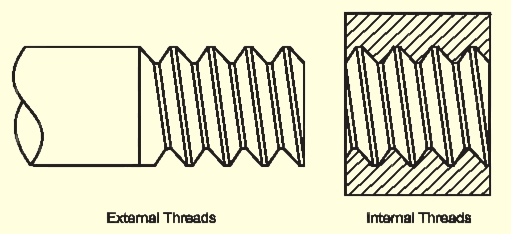
스레드 표준 및 분류
나사산 표준은 나사산의 측정, 라벨링 및 제조 방법을 정의합니다. 서로 다른 제조업체에서 만든 부품 간의 호환성을 보장합니다.
통합 스레드 표준(UN 및 UNC/UNF)
통합 스레드 표준(UN)은 미국, 캐나다 및 기타 여러 국가에서 널리 사용되고 있습니다. 이 표준은 굵은 나사산과 가는 나사산을 모두 정의하여 산업 전반에 걸쳐 일관된 치수를 보장합니다.
- UNC(통일 국가 거친) 나사는 인치당 나사산 수(TPI)가 적기 때문에 더 튼튼하고 조립하기 쉽습니다. 예를 들어 1/4"-20 UNC 나사는 20 TPI로, 1인치에 20개의 나사산이 있습니다. 거친 디자인은 알루미늄과 같이 부드러운 소재에서 벗겨짐에 대한 저항력을 향상시킵니다.
- UNF(통합 국가 벌금) 나사는 인치당 나사산이 더 많습니다. 예를 들어 1/4"-28 UNF 나사는 28 TPI입니다. 미세한 피치는 더 큰 체결력을 허용하며 단단한 재료나 정밀한 조정이 필요한 용도에 이상적입니다.
- UNEF(통합 국가 추가 벌금) 스레드는 덜 일반적이지만 항공 우주 또는 정밀 기기처럼 스레드 결합 공간이 제한된 곳에서 사용됩니다.
ISO 미터법 스레드
ISO 미터법 스레드 시스템은 가장 널리 사용되는 글로벌 표준으로, ISO 68-1 및 ISO 965-1에 의해 관리됩니다. 유럽, 아시아 및 많은 국제 시장에서 일반적입니다. 모든 측정에 인치 대신 밀리미터를 사용합니다.
미터법 스레드는 문자 M과 그 뒤에 공칭 직경 및 피치로 식별됩니다. 예를 들어
- M8 × 1.25 는 8mm 기본 직경과 1.25mm 피치를 의미합니다.
- M10 × 1.5 는 직경 10mm, 피치 1.5mm입니다.
미터법 스레드는 통합 스레드와 동일한 60° 스레드 각도를 사용하지만 표준 애플리케이션에서 외부 스레드의 경우 6g, 내부 스레드의 경우 6H로 표시되는 다른 공차 시스템을 적용합니다.
제조 가능성을 위한 스레드 설계
좋은 스레드 디자인은 단순히 적절한 크기와 피치를 고르는 것 이상의 의미를 갖습니다. 스레드는 가공하기 쉽고, 하중을 견딜 수 있을 만큼 강해야 하며, 품질이 일정해야 합니다.
최소 벽 두께 및 스레드 결합
구멍이 있거나 벽이 얇은 부품의 경우 충분한 벽 두께를 유지하는 것이 중요합니다. 얇은 벽은 가공 중에 휘어질 수 있으며 하중을 받으면 구부러지거나 갈라질 수 있습니다.
일반적으로 벽 두께는 스레드의 기본 직경의 1.5배 이상을 유지하는 것이 좋습니다. 예를 들어 M8 나사(직경 8mm)는 벽 두께가 최소 12mm 이상이어야 합니다. 알루미늄과 같이 부드러운 소재의 경우 안정성을 높이려면 두께를 직경의 2배로 늘리세요.
나사산 맞물림은 나사산 길이 중 실제로 하중을 전달하는 부분을 의미합니다. 대부분의 애플리케이션은 최대 강도를 위해 스레드 직경의 1~1.5배가 필요합니다.
언더컷과 급격한 전환 피하기
언더컷과 날카로운 모서리는 약점과 응력이 가해지는 부분을 만들 수 있습니다. 특히 반복되는 하중에서 균열을 줄이려면 스레드가 스레드가 없는 부분으로 부드럽게 전환되어야 합니다.
런아웃 릴리프 또는 스레드 릴리프 홈을 사용하여 깔끔한 스레드 종단을 보장합니다. 릴리프 폭은 스레드 피치의 1.5배, 깊이는 스레드 루트 직경보다 약간 큰 것이 좋습니다.
스레드 근처의 날카로운 내부 모서리를 피하세요. 대신 필렛이나 모따기를 사용합니다. 일반적으로 0.5~1.0mm의 반경은 응력을 고르게 분산시킵니다. 또한 부드러운 전환은 CNC 공구가 깨끗하게 배출되어 표면 조도를 개선하고 버를 줄이는 데 도움이 됩니다.
적절한 스레드 깊이 선택
통일 및 미터법 60° 나사산의 경우 표준 깊이는 0.613 × 피치입니다. 예를 들어, M6 × 1.0 스레드의 이론적 깊이는 0.613mm입니다. 실제로 기공사는 공구 동작을 개선하고 게이지에 적절히 맞도록 하기 위해 깊이를 5-10%까지 줄이는 경우가 많습니다.
딥 스레드 막힌 구멍 칩과 절삭유가 끼어 공구가 손상될 수 있습니다. 이를 방지하려면 구멍 바닥에 평평한 릴리프를 남겨두거나 나사산 밀링을 사용하여 칩 간격을 개선하세요.
막힌 구멍의 경우 전체 나사산 길이를 구멍 깊이보다 1.5피치 이상 짧게 유지합니다. 이렇게 하면 칩을 위한 공간을 확보하고 공구 충돌을 방지할 수 있습니다.
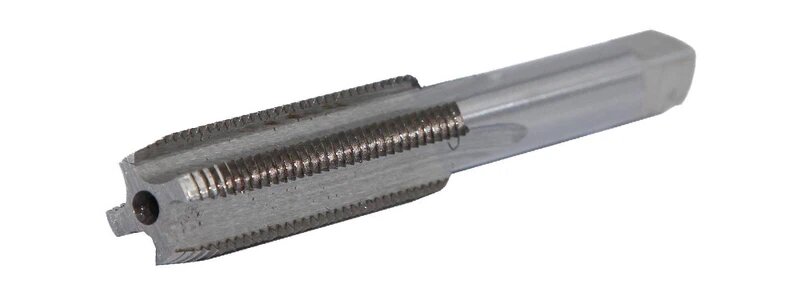
피해야 할 일반적인 스레드 디자인 실수
숙련된 설계자라도 CNC 스레딩에서 심각한 문제를 야기하는 작은 실수를 할 수 있습니다. 이러한 일반적인 실수를 인식하면 정확하고 가공하기 쉬운 나사산을 설계할 수 있습니다.
지나치게 엄격한 허용 오차
많은 디자이너는 더 엄격한 허용 오차가 더 나은 품질과 같다고 생각합니다. 하지만 항상 그런 것은 아닙니다. 공차가 엄격하면 가공 시간이 길어지고 공구가 더 빨리 마모되며 조립이 더 어려워질 수 있습니다.
대부분의 부품에는 통일 나사산의 경우 2A/2B, 미터 나사산의 경우 6g/6H의 표준 맞춤이 잘 맞습니다. 정밀한 정렬 또는 고압 씰링의 경우에만 더 타이트한 맞춤이 필요합니다.
예를 들어, 6H 맞춤의 M10 × 1.5 나사산은 이미 ±0.13mm 이내의 정확도를 유지합니다. 이를 ±0.05mm로 조이면 일반적으로 성능 향상 없이 비용만 추가됩니다. 또한 검사 시 불합격률도 높아집니다.
공차가 엄격하면 특히 다음과 같은 코팅의 경우 조립 중에 부품이 고착될 수 있습니다. 아연 도금 또는 아노다이징 처리 가 적용됩니다. 이러한 처리는 표면당 5-15µm를 추가할 수 있습니다. 실용적인 공차는 공구 스트레스를 줄이고 일관성을 개선하며 재작업을 줄입니다.
불충분한 스레드 참여
스레드 맞물림은 하중을 전달하는 스레드 부분입니다. 결합이 너무 적으면 스레드가 벗겨지거나 느슨해질 수 있습니다.
일반적인 규칙: 강철의 경우 공칭 직경의 1배, 알루미늄이나 황동과 같은 부드러운 금속의 경우 1.5배. 예를 들어, M8 × 1.25 나사산은 강철의 경우 최소 8mm, 알루미늄의 경우 12mm 이상 맞물려야 합니다.
대부분의 하중은 처음 몇 개의 결합된 나사산에 의해 전달되며, 처음 세 개의 나사산에서 80% 이상이 전달됩니다. 더 많은 결합을 추가해도 강도는 거의 향상되지 않지만 가공 시간과 공구 마모는 증가합니다.
벽이 얇은 부품의 경우 균열을 방지하기 위해 나사산 뒤에 충분한 재료가 있는지 확인합니다. 플라스틱 또는 인서트의 경우 나사산을 강화하기 위해 나선형 인서트 또는 나사산 부싱을 고려하세요.
도구 액세스 또는 클리어런스 무시
스레드는 도구가 원활하게 자르고 빠져나갈 수 있는 공간이 필요합니다. 접근성이 좋지 않으면 충돌, 불완전한 스레드 또는 주변 피처의 손상이 발생할 수 있습니다.
CNC 탭과 나사산 밀링에는 축 방향 및 반경 방향 안전거리가 필요합니다. 막힌 구멍의 경우 칩 제거를 위해 바닥에 나사산이 없는 공간을 1.5피치 남겨두세요. 이 공간이 없으면 칩이 공구에 끼어 공구가 파손될 수 있습니다.
예를 들어, M10 × 1.5 블라인드 홀을 나사 가공하려면 홀 깊이가 전체 나사 직경보다 최소 1.5mm 더 깊어야 합니다. 숄더 근처의 외부 스레드의 경우 스레드 루트보다 약간 더 깊고 1.5배 피치 너비 이상의 런아웃 홈을 추가합니다.
3D 모델에서 공구 경로를 확인합니다. 나사산에 너무 가까운 피처는 접근을 차단할 수 있습니다. 입구에 약간의 모따기나 릴리프를 추가하면 탭이나 커터가 깔끔하게 시작되고 버를 줄일 수 있습니다.
기술 도면에 스레드 지정
잘 설계된 스레드는 문서화만큼 좋은 것입니다. 적절한 콜아웃, 허용 오차 정의, 검사 노트는 모든 생산 배치에서 일관된 결과를 보장합니다.
명확하고 모호하지 않은 스레드 콜아웃
스레드 콜아웃은 유형, 크기, 피치, 핏 등급을 설명합니다. ASME Y14.6 또는 ISO 965-1과 같은 국제 표준을 따라야 합니다. 명확한 콜아웃은 기계공이 어떤 공구와 공정을 사용할지 빠르게 이해하는 데 도움이 됩니다.
통합 스레드의 경우 일반적으로 다음과 같은 형식입니다:
1/4-20 UNC-2B
- 1/4 → 주요 직경(인치)
- 20 → 인치당 스레드 수(TPI)
- UNC 스레드 시리즈(통일된 국가 거친) → 스레드 시리즈
- 2B → 핏 클래스(내부 스레드)
메트릭 스레드의 경우 형식은 다음과 같습니다:
M10 × 1.5 - 6H
- M10 → 주요 직경(mm)
- 1.5 → 피치(mm)
- 6H → 내부 스레드 허용 오차 클래스
스레드가 스루인지 블라인드인지 지정합니다. "스루" 또는 "깊이 15mm"와 같은 메모는 CNC 프로그래밍 중 혼동을 방지합니다.
필요한 경우 콜아웃에 표면 마감 또는 도금을 포함하세요. 예를 들어
M8 × 1.25 - 6시간, 아연 도금 후
이를 통해 기계 작업자는 실을 절단할 때 코팅 두께를 고려할 수 있습니다.
맞춤 및 기능에 대한 스레드 클래스 허용 오차 정의
나사산 공차는 부품이 서로 얼마나 단단히 맞물리는지를 제어합니다. 올바른 등급을 선택하면 조립, 부하 용량 및 제조 가능성에 큰 영향을 미칠 수 있습니다.
통합 스레드 범위는 1A/1B(느슨함)에서 3A/3B(단단함)까지입니다:
- 1A/1B: 빠른 조립을 위한 느슨한 핏으로 중요하지 않거나 더러운 환경에 이상적입니다.
- 2A/2B: 대부분의 산업용 부품에 표준으로 적합합니다.
- 3A/3B: 항공우주, 계측 또는 유압 애플리케이션에 적합한 고정밀 제품입니다.
성적 번호와 문자는 메트릭 스레드를 식별합니다. 예를 들면 다음과 같습니다:
- 6H(내부) / 6g(외부): 표준 범용 핏입니다.
- 5H/5G: 고정밀 부품에 더욱 밀착됩니다.
- 7H/7g: 느슨한 핏으로 조립이 간편합니다.
예를 들어, M12 × 1.75 - 6H/6g는 피치 직경 공차가 약 ±0.15mm로 정밀도와 조립 용이성 간의 균형이 잘 잡혀 있습니다. 지나치게 엄격한 공차는 성능 향상 없이 공구 마모와 검사 시간을 증가시키므로 필요한 경우가 아니라면 공차를 지나치게 엄격하게 지정하지 마십시오.
검사 및 품질 요구 사항 전달
검사를 통해 스레드의 품질과 적절한 부품 장착을 보장합니다. 도면에 대한 명확한 검사 노트를 통해 품질 관리 시 일관성을 유지할 수 있습니다.
표준 검사 요구 사항에는 다음이 포함됩니다:
- 이동/이동 안 함 게이지 테스트: 내부 및 외부 스레드의 기능적 적합성을 확인합니다.
- 피치 직경 측정: 정확한 체결을 보장합니다. 3선식 또는 나사 마이크로미터로 측정하며, 정밀 부품의 경우 일반적으로 ±0.02mm 이내로 측정합니다.
- 표면 마감: 원활한 결합을 위해 중요합니다. 일반적인 값은 애플리케이션에 따라 Ra 1.6µm에서 Ra 3.2µm입니다.
- 육안 검사: 버, 불완전한 나사산 또는 공구 자국이 있는지 확인합니다.
중요한 구성 요소의 경우 다음과 같은 메모를 포함하세요:
클래스 2B 이동/노고 게이지로 검사할 스레드
또는
첫 번째 기사에는 1001T3PT 스레드 검사 필요
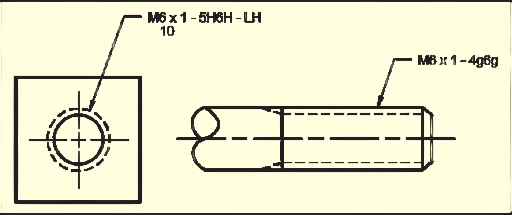
삽입: 스레딩의 대안
때로는 기존 스레드가 최선의 선택이 아닐 수도 있습니다. 얇은 벽, 부드러운 소재 또는 높은 강도의 요구 사항으로 인해 태핑이 어렵거나 불안정할 수 있습니다. 스레드 인서트는 강력하고 내구성이 뛰어난 대안을 제공합니다. 인서트는 하중 용량을 늘리고, 부품 수명을 연장하며, CNC 공구의 마모를 줄여줍니다. 또한 인서트를 사용하면 유지보수 및 교체가 더 쉬워집니다.
인서트 사용의 이점
- 힘이 향상되었습니다: 인서트는 부드러운 소재의 작은 구멍이 큰 강철 실과 동일한 하중을 전달할 수 있도록 합니다.
- 내구성: 특히 진동이 심한 부품의 경우 반복 조립 후에도 벗겨지지 않습니다.
- 유연성: 손상된 인서트는 전체 부품을 교체할 필요 없이 교체할 수 있습니다.
- 가공 효율성: 인서트로 절단된 나사산은 모재에 직접 절단하는 것보다 공구 마모를 줄여줍니다.
디자인 고려 사항
- 구멍 지름을 인서트 제조업체의 권장 사항에 맞춥니다.
- 설치 중 균열이 생기지 않도록 인서트 주변의 벽 두께를 충분히 유지하세요.
- 기술 도면에 삽입 유형, 설치 방법, 깊이 및 방향을 명확하게 지정합니다.
스레드 인서트는 부드러운 소재, 얇은 벽 또는 고하중 응용 분야에 적합한 실용적인 솔루션입니다. 강도, 신뢰성 및 조립 용이성을 결합하여 CNC 부품의 기존 스레딩에 대한 확실한 대안이 될 수 있습니다.
스레드 디자인을 한 단계 업그레이드
CNC 가공용 나사산 설계가 복잡할 필요는 없습니다. 나사산 형상, 결합, 공차 및 제조 가능성에 초점을 맞추면 튼튼하고 정밀할 뿐만 아니라 조립하기 쉬운 부품을 만들 수 있습니다. 지나치게 엄격한 공차, 불충분한 결합, 공구 접근성 저하와 같은 일반적인 실수를 방지하여 시간을 절약하고 비용을 절감하며 안정적인 성능을 보장할 수 있습니다.
스레드 설계를 최적화하는 데 전문가의 도움이 필요하거나 정밀한 CNC 부품이 필요한 경우, 지금 팀에 문의하세요. 도면을 검토하고 개선 사항을 제안하며 설계를 고품질의 제조 가능한 구성 요소로 전환하는 데 도움을 드릴 수 있습니다. 잘못된 스레드 설계로 인해 프로젝트가 지연되지 않도록 지금 전문가의 도움을 받으세요.
안녕하세요, 저는 케빈 리입니다

지난 10년 동안 저는 다양한 형태의 판금 제작에 몰두해 왔으며 다양한 워크숍에서 얻은 경험에서 얻은 멋진 통찰력을 이곳에서 공유했습니다.
연락하세요

케빈 리
저는 레이저 절단, 굽힘, 용접 및 표면 처리 기술을 전문으로 하는 판금 제조 분야에서 10년 이상의 전문 경험을 갖고 있습니다. Shengen의 기술 이사로서 저는 복잡한 제조 문제를 해결하고 각 프로젝트에서 혁신과 품질을 주도하는 데 최선을 다하고 있습니다.

